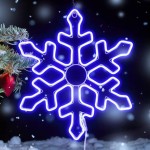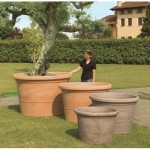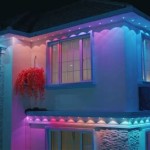Outdoor Topiary Trees With Lights: A Guide to Illuminating Greenery
Outdoor topiary trees with lights offer a unique blend of horticultural artistry and decorative illumination, enhancing the aesthetic appeal of gardens, patios, and entryways. These living sculptures, shaped into various forms and adorned with integrated lighting, provide both visual interest during the day and a warm, inviting glow at night. The selection, placement, and maintenance of these illuminated topiaries require careful consideration to ensure longevity and maximize their decorative impact. This article explores the various aspects of outdoor topiary trees with lights, including available options, design considerations, installation techniques, and maintenance practices.
The concept of topiary dates back centuries, originating in ancient Rome. Early topiaries were primarily forms created from evergreen shrubs like boxwood and cypress. Modern topiary has expanded to encompass a wider range of plants and techniques, including wire-frame structures and artificial materials. Adding lights to these sculptures elevates their decorative function, making them focal points even after sunset. The integration of lighting can range from simple string lights wrapped around the form to more sophisticated LED systems that are embedded within the topiary itself.
The growing popularity of outdoor topiary trees with lights is driven by their versatility and ease of integration into various landscaping styles. They can serve as standalone features, line pathways, or complement existing garden elements. The illuminated aspect allows for year-round enjoyment, providing ambiance during the darker months and creating a festive atmosphere for special occasions.
Understanding the Options: Types of Topiary Trees and Lighting
The selection of an outdoor topiary tree with lights involves considering both the type of topiary form and the style of lighting. Topiaries can be broadly categorized into living and artificial forms, each with distinct advantages and disadvantages. Living topiaries require ongoing maintenance, including pruning, watering, and fertilization, while artificial topiaries offer a low-maintenance alternative. The choice between the two depends on individual preferences and the level of commitment to plant care.
Living topiaries typically utilize evergreen shrubs that respond well to pruning, such as boxwood, yew, and privet. These plants can be trained into various shapes, including geometric forms, spirals, and animal figures. The training process often involves a wire frame to guide the growth of the plant. Artificial topiaries, on the other hand, are constructed from synthetic materials that mimic the appearance of real foliage. These materials are often weather-resistant and UV-protected, ensuring that the topiary retains its color and shape over time.
The type of lighting used in outdoor topiary trees can significantly impact their aesthetic appeal. String lights are a common option, offering a simple and cost-effective way to add illumination. LED lights are increasingly popular due to their energy efficiency, long lifespan, and ability to produce a wide range of colors. These lights can be woven into the foliage or attached to the underlying frame. Solar-powered lights provide a convenient and environmentally friendly alternative, eliminating the need for electrical outlets. However, their performance depends on the amount of sunlight they receive.
When choosing lighting for a topiary, consider the color temperature of the lights. Warm white lights (around 2700K) create a cozy and inviting atmosphere, while cool white lights (around 4000K) provide a brighter and more modern look. The intensity of the lights should also be considered, as overly bright lights can be distracting, while dim lights may not provide sufficient illumination. Adjustable lighting systems allow for customizing the brightness and color of the lights to suit different occasions and preferences.
Another factor to consider is the safety of the lighting system. Ensure that the lights are designed for outdoor use and are properly insulated to prevent electrical hazards. Low-voltage lighting systems are generally safer than high-voltage systems, especially in areas where children or pets may be present.
Design and Placement Considerations: Integrating Topiaries into the Landscape
The successful integration of outdoor topiary trees with lights into a landscape design requires careful consideration of their placement, scale, and style. The topiaries should complement the existing landscape elements, such as trees, shrubs, and flowers, creating a harmonious and visually appealing composition. The scale of the topiaries should be proportionate to the surrounding space, avoiding both overpowering and underwhelming effects. The style of the topiaries should be consistent with the overall design theme of the garden or outdoor area.
Consider the architectural style of the house and the surrounding landscape when selecting the shape and style of the topiary. Formal gardens often feature geometric topiaries, such as spheres, cones, and pyramids, arranged in symmetrical patterns. Informal gardens may incorporate more whimsical shapes, such as animal figures or abstract designs, placed in a more relaxed and naturalistic manner.
The placement of topiary trees with lights can be used to achieve various design goals. They can serve as focal points, drawing the eye to specific areas of the garden. They can be used to define pathways and create a sense of enclosure. They can also be used to add height and visual interest to otherwise flat or monotonous landscapes.
When placing illuminated topiaries near walkways or entrances, consider the potential for glare. Ensure that the lights are positioned in a way that illuminates the path without causing discomfort or disorientation. Use shielded lights or direct the light downwards to minimize glare and light pollution.
The background against which the topiaries are placed can also influence their visual impact. A dark background will make the lights stand out more prominently, while a light background will soften the contrast. Consider using contrasting textures and colors to highlight the shape and form of the topiary.
The season of the year can also influence the placement and arrangement of topiary trees with lights. During the winter months, when other plants are dormant, the topiaries can provide much-needed visual interest and light. During the summer months, they can serve as accents to complement the blooming flowers and lush foliage.
Maintenance and Care: Ensuring Longevity and Beauty
The maintenance and care of outdoor topiary trees with lights vary depending on whether they are living or artificial. Living topiaries require regular pruning, watering, fertilization, and pest control, while artificial topiaries require minimal maintenance. Proper care is essential to ensure the longevity and beauty of these decorative elements.
Living topiaries should be pruned regularly to maintain their shape and prevent them from becoming overgrown. The frequency of pruning will depend on the growth rate of the plant and the desired shape. Use sharp pruning shears to make clean cuts, avoiding tearing or crushing the branches. Remove any dead, damaged, or diseased branches promptly.
Water living topiaries regularly, especially during dry periods. The amount of water needed will depend on the type of plant, the soil conditions, and the weather. Avoid overwatering, as this can lead to root rot. Fertilize living topiaries regularly with a balanced fertilizer to promote healthy growth. Follow the instructions on the fertilizer label carefully.
Inspect living topiaries regularly for signs of pests or diseases. Treat any problems promptly to prevent them from spreading. Common pests that can attack topiaries include aphids, spider mites, and scale insects. Common diseases include fungal infections and root rot.
Artificial topiaries can be cleaned periodically with a mild soap and water solution to remove dust and dirt. Avoid using harsh chemicals or abrasive cleaners, as these can damage the synthetic materials. Inspect the lighting system regularly for any signs of damage or wear. Replace any burnt-out bulbs or damaged wires promptly.
During periods of inclement weather, such as strong winds or heavy snow, consider protecting the topiaries to prevent damage. Living topiaries can be wrapped in burlap or moved to a sheltered location. Artificial topiaries can be secured to the ground with stakes or weights. Regularly check the stability of the topiary, especially after extreme weather events.
For solar-powered lights, ensure the solar panel is kept clean and free from obstructions. Position the panel in a location that receives ample sunlight throughout the day to maximize the battery charge.

Solar Powered 4ft 5ft 6ft 70cm 82cm Cone Topiary Trees Leaf Branch Lights Garden

Better Homes Gardens 22 H Topiary Outdoor Tall Decor With Battery Powered Warm White Led Lights Eyebright Com

Outdoor Boxwood Artificial Topiary Balsam Hill

48 Inch Indoor Outdoor Uv Protected Boxwood Cone Topiary Tree With Battery Operated Lights Living Spaces

Home Heritage 4 Foot Artificial Topiary Tree W Clear Lights For Entryway Decor Com

Smart Garden Trio Topiary Ball Tree 80cm Decorative Artificial Indoor Outdoor
.png?strip=all)
Outdoor Topiaries Artificial Topiary Trees Plants

Better Homes Gardens 18 H Topiary Outdoor Round Decor With Solar Powered Warm White Led Lights Pine Needle Com

Outdoor Boxwood Artificial Topiary Balsam Hill

Coogee Green Black Topiary Plastic Grass Ball Solar Powered Integrated Led Outdoor Stake Light Diy At B Q
Related Posts







